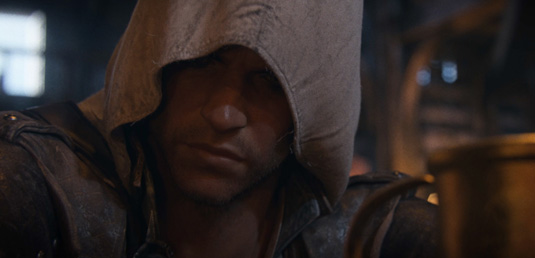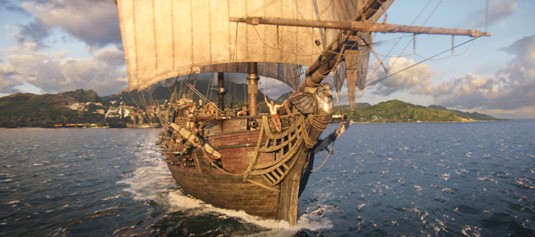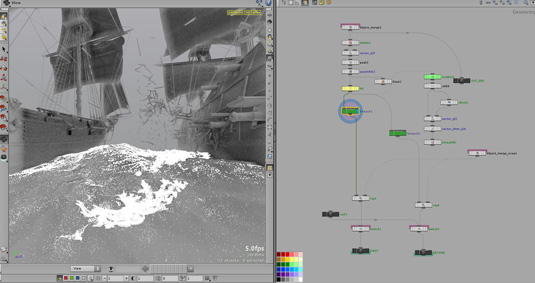How the swashbuckling Assassin's Creed trailer was made
Get ready to set sail on the journey of a lifetime in this awe-inspiring 3D trailer for the latest release of the action-adventure videogame.
Last week, the sixth installment in the Assassins Creed series went on sale. To conicide with the release of Assassin's Creed IV: Black Flag, Hungarian 3D animation studio Digic Pictures created this epic trailer, designed to show off the game's graphics and scenery, including new cities Havana, Kingston and Nassau
Here, we speak to project director Peter Sved about its production...
Q: How did the brief come about?
We’ve been working together with Ubisoft for several years now, having produced all trailers for the Assassin’s Creed franchise since the Assassin’s Creed 2 E3 trailer in 2009. For Assassin’s Creed Black Flag, we received the initial brief in the second half of 2012. We needed to create two distinct trailers. First up, an announcement trailer, where the infamous pirate Blackbeard introduces the game’s main protagonist, Edward Kenway.
Then for E3, the brief called for a more evolved storyline that begins with a bar-fight (which is actually a cover for an assassination) and progresses into a high-sea chase and naval battle. There were several overlaps between the two films in terms of the assets we needed to produce (both set and character assets) - this was something we needed to keep in mind to optimize our production schedule.

Q: Did you have a lot of artistic freedom?
Over the years we’ve developed a very good working relationship with Ubisoft - a relationship built on trust. As such, Ubisoft is, in general, very open to our ideas and our creative solutions as to how we realise the given brief. Of course, we do our best to fully identify with the script and make sure that our ideas serve the story that the client wants to tell.
Q: Talk us through your design approach to the project...
First of all, it all came down to the research made for the various environments. We began by collecting concepts and reference images, taking into consideration not only the given period (around 1715) but also the level of wear and ageing needed. We used these as a starting point for modelling, and during texturing we made sure everything looks used (but not antiquated), and true to the period.
It was challenging to bring the 3D environment up to the standards of the matte-paintings
About half of the available production time was used for actual modeling and texturing, while the other half was used for layout, refined in several steps. It was particularly challenge to bring the 3D environment up to the standards of the matte-paintings in terms of their wealth and proportion of fine details.

To be able to set the appropriate mood and provide backdrop to the story itself, several hundred individual props and unique set elements were created (usually over 500 on AC trailers) some of which were further multiplied by a couple of colour variations.
Q: What 3D software did you use?
As far as asset creation is concerned, for hard-surface modeling we generally use Maya and 3ds Max, while we mostly use ZBrush for organic modeling, like sculpting heads and bodies. Texturing is mostly done in BodyPaint and Photoshop, which we also use for mattepainting.
We use our own proprietary shader for Arnold, which has been our renderer of choice for the past few years. Compositing is done in Nuke. For effects, we use Houdini as well as FumeFx. Hair and fur are created in Yeti and simulated via nHair and Syflex, the latter of which we also use for cloth simulation, together with nCloth. We handle crowd shots using Massive.

Q: What software was the most useful?
That’s actually pretty hard to say. The core of our production pipeline is Maya, where all of our scene assembly, animation work, and shot management takes place. But I would also highlight the importance of Nuke, which we’ve been using since the very early days, having originally bought it from Digital Domain back in 2003.
Q: What was the most technically impressive aspect of this project?
One of our overall technical aims over the past few years has been to unify our workflow to be able to run our FumeFx simulations within Maya and render the results just like we do everything else, with the Arnold renderer. So we’ve actually developed and integrated our own FumeFX plugin for Maya, in collaboration Luma Pictures. The results of this work can be seen in the naval battle sequence of this trailer.

Q: Did you use any new or notable techniques during production?
We decided very early on that Edward’s rag-tag crew of pirates could not be created with some modular system, where we would just re-use various pieces and randomly generate the characters. It would not have been enough to make each of them truly unique and alive.
Our solution was to take a thorough look at our character pipeline and streamline everything we could, so that we could build as many unique character assets as efficiently as possible within the given budgets and schedules. It was a bit risky as we haven’t had enough time to test the new methods in practice, but everything worked out well in the end.

Liked this? Read these!
- Top free 3D models
- Best 3D movies of 2013
- Blender tutorials: ways to create cool effects
Have you seen any inspirational 3D work recently? Let us know in the comments...

Thank you for reading 5 articles this month* Join now for unlimited access
Enjoy your first month for just £1 / $1 / €1
*Read 5 free articles per month without a subscription

Join now for unlimited access
Try first month for just £1 / $1 / €1
Get the Creative Bloq Newsletter
Daily design news, reviews, how-tos and more, as picked by the editors.

The Creative Bloq team is made up of a group of design fans, and has changed and evolved since Creative Bloq began back in 2012. The current website team consists of eight full-time members of staff: Editor Georgia Coggan, Deputy Editor Rosie Hilder, Ecommerce Editor Beren Neale, Senior News Editor Daniel Piper, Editor, Digital Art and 3D Ian Dean, Tech Reviews Editor Erlingur Einarsson, Ecommerce Writer Beth Nicholls and Staff Writer Natalie Fear, as well as a roster of freelancers from around the world. The ImagineFX magazine team also pitch in, ensuring that content from leading digital art publication ImagineFX is represented on Creative Bloq.
